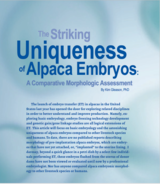Two-Part Series

|
Comprehensive Look Into Dilution Genetics & Our 10 Year Farm Study

Thank you for your interest in this new article. This is a comprehensive review of color dilution genetics in alpacas, and results of a 10 year long study into dilution inheritance on our farm ! This article has been published in the current issue of Alpacas Magazine, Spring 2024. Contact the Alpacas Owners Association to order your own copy. I hope to be able to provide a link in the near future. ... Full article >
|
Presented at The Parade of Champions Auction 2017

Working in the field of human embryology for my entire life and freezing literally thousands of eggs and embryos, it was only a matter of time before I decided to try to freeze alpaca embryos. Historically all of the literature recording various attempts at freezing embryos in alpacas had failed, and it was presumed that it was just not possible. I assembled my research team at the time that included Lynn Edens and Arturo Peno and we set up a series of trials breeding females and then flushing r... Full article >
|
Alpaca Culture Magazine 2018

Thank you for reading our amazing study into alpaca embryology!... Full article >
|
Theriogenology Veterinary Journal 2017

Time of Breeding Can Influence Cria Gender Ratios in Alpacas Kim Gleason, PhD1, Lynn Edens2, Arturo Pena2 1 Dancing Horse Farm, Pemberton, NJ 08068, 2 Little Creek Farm, North Salem, NY 10560 The control of gender for economic gains in livestock production has been widely investigated, and anecdotally unsuccessful. Production gender ratios are generally left to chance, except for usage of commercial sperm sorting or other invasive and costly reproductive technologies. The objective of th... Full article >
|
Calpaca Connection Winter 2023

|
MAPACA Journal 2017

There are so many common poisonous or noxious plants, trees and berries in our region that we have to watch out for around our alpacas. We hear of these over and over: wild cherry, buttercups, red oak, azalea, rhododendron, hemlock, the list goes on and on. But what about the more unusual health threats that can pop up in your pastures? In this article, I will describe a few dangerous plants found in the mid-atlantic region that may be overlooked for their rarity, or toxic and negative eff... Full article >
|
Examples From One Herd
In recent years, US alpaca breeders’ continued efforts to produce incremental improvements in alpaca phenotypes, combined with the related and parallel trend of loss of genetic diversity within the closed US alpaca population, has increased interest in understanding the implications of line breeding alpacas. Unfortunately, while there has been substantial research on line breeding results in some other livestock species, there is little species-specific guidance available for alpaca breeders, a... Full article >
|
Showtacular Journal 2016

Can a Cria’s Immunity Be Predicted By the Dam’s IgG Before Birth? Kim Gleason1, PhD, Lynn Edens2, and Arturo Pena2 1 Dancing Horse Farm, Pemberton, NJ; 2Little Creek Farm, North Salem, NY That is one question that Kim Gleason and Lynn Edens asked over a year ago when they began a multi-faceted, multi-site research study. One of the goals of their massive research project was to determine if an IgG sample taken from females within 60 days of anticipated birth could predict failure of passive... Full article >
|
Presented at the Theriogenology Veterinary Conference 2016

We are very proud to announce that the first part of our year-long research study has been accepted for publication in the prestigious scientific veterinary journal, Theriogenology. I was thrilled to have our work recognized by the scientific community & given the opportunity to present our findings at the Theriogenology annual meeting in July. This important study was overwhelmingly received positively by veterinarians from all over the country: Do Differences I... Full article >
|

Alpacas are South American camelids, cousins to the larger framed llama and smaller deer-like vicuna. The majority of alpacas come from Chile, Bolivia, and the mountains of Peru. In Peru, native Indians, called the Quechua Indians maintain and preserve wild alpaca herds. Alpacas were first imported into this country in the mid 1980's. With the threat of mad cow disease and other deadly infectious diseases, howeve... Full article >
|
Witnessing an Alpaca Birth

They say a watched pot never boils. Nothing could be more true when anticipating an alpaca birth. We spend countless hours staring at our pregnant females looking for signs of impending labor, despite the fact that there is no real consistency of what the heck we’re looking for. Some expectant moms may seem restless, a few may just lay around, but most don’t seem any different at all; even within a few hours of giving birth. We’ve looked and examined moms-to-be every which way, angle, direct... Full article >
|
Alpacas Magazine Spring 2013

Thank you for your interest in our articles. This article has been submitted to Alpacas Magazine and has been accepted. Please look for us in this 2013 spring issue!!! Copy and past the link below in your browser to read our article! https://www.alpacainfo.com/members/am/2013-spring/assets/basic-html/page-48.html... Full article >
|
The Alpaca Industry Today

There's so much information out there about alpacas and the alpaca industry today that quite often new folks thinking about first time investing in alpacas can become overwhelmed and confused. At Dancing Horse Farm, we're not only involved in agriculture tourism in New Jersey, we welcome anyone to our farm to learn about alpacas, the alpaca industry, and the micro-textile industry. We listen to what folks say about what they've "heard" about alpacas, investing, and where they think the alpaca in... Full article >
|